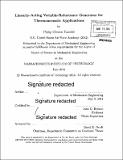Linearly-acting variable-reluctance generator for thermoacoustic applications
Author(s)
Knodel, Philip Clinton
DownloadFull printable version (21.16Mb)
Other Contributors
Massachusetts Institute of Technology. Department of Mechanical Engineering.
Advisor
John G. Brisson.
Terms of use
Metadata
Show full item recordAbstract
Advances in battlefield equipment have created a demand for portable power systems with greater power density and more flexibility than current battery sources alone can provide. One potential solution lies in portable, high-frequency thermoacoustic engines, which can provide a battery recharge station or direct power supply for soldiers in-field, with the flexibility of operating on any quality heat source such as a butane heater. In this work, a linearly-acting variable-reluctance generator (VRG) is developed to act as a high-frequency (250 Hz) electro-acoustic transducer and extract electric power from a proposed thermoacoustic engine design. A computational model of the thermoacoustic engine was developed using DeltaEC to determine the feasibility of the concept and the necessary characteristics of the transducer element. The unique requirements of the high-frequency thermoacoustic engine led to the design, optimization, fabrication, and testing of the VRG, which is designed to operate resonantly in the thermoacoustic system and supported by a self-pumping gas bearing system. The VRG is uniquely suited to efficiently convert small amplitude mechanical oscillations (5 mm in this work) into electric power. Linear and nonlinear saturation models of the transducer were developed to optimize the VRG design and predict transducer performance in the thermoacoustic engine. The accuracy of these models was established by comparing simulation results to static experimental data and dynamic experimental data taken at 50-60 Hz oscillation frequency, testing one half of the full transducer. Experimental testing resulted in a maximum power output of 5.74 Watts with an efficiency of 55.8%. The results led to the conclusion that the transducer would function as designed in the thermoacoustic engine. Recommendations for future work and guidelines for future development of the engine, transducer, and bearing system are provided based on the design and results presented in this work.
Description
Thesis: S.M., Massachusetts Institute of Technology, Department of Mechanical Engineering, 2014. Cataloged from PDF version of thesis. Includes bibliographical references (pages 149-151).
Date issued
2014Department
Massachusetts Institute of Technology. Department of Mechanical EngineeringPublisher
Massachusetts Institute of Technology
Keywords
Mechanical Engineering.